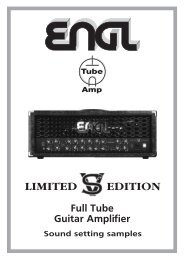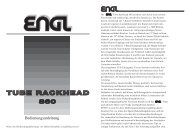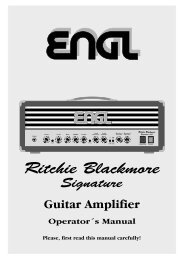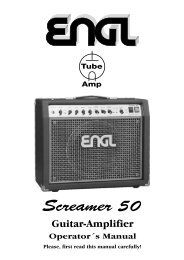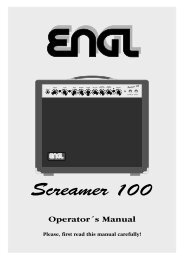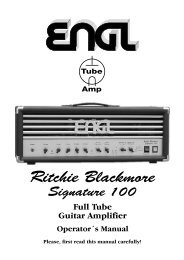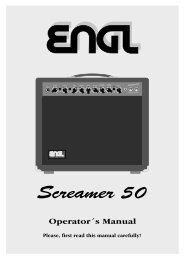LIMITED EDITION - Engl
LIMITED EDITION - Engl
LIMITED EDITION - Engl
Create successful ePaper yourself
Turn your PDF publications into a flip-book with our unique Google optimized e-Paper software.
27 Master A<br />
Master A volume knob. Located post effect loop, it controls power amp output. The<br />
red LED to the right of the knob lights up to indicate Master A is enabled and<br />
determining the master level.<br />
You can switch between Master A and Master B using a Z-9 Custom Footswitch (S.A.C.<br />
F1-1, page 26)<br />
connected to the S.A.C. Port (33) or a footswitch connected to jack (35).<br />
For more details see the chapter 33 and 35 on page 13 and 14!<br />
28 Master B<br />
Master B volume knob. Located post effect loop, it controls power amp output. The<br />
green LED to the right of the knob lights up to indicate Master B is enabled and<br />
determining the master level.<br />
You can switch between Master A and Master B using a Z-9 Custom Footswitch (S.A.C.<br />
F1-1, page26) connected to the S.A.C. Port (33) or a footswitch connected to jack (35).<br />
For more details see the chapter 33 and 35 on page 13 and 14!<br />
A tip from the designer:<br />
If you want to experience real remote control convenience, try an ENGL Z-9 foot<br />
controller. You can dial in different levels for Master A and Master B,<br />
assign these<br />
settings to any channel and access them directly via the four channel switches on the<br />
ENGL Z-9 foot controller. This gives you a range of alternatives that you can apply to<br />
different playing styles and musical genres to great dramatic effect. What's more, you<br />
can use Clean & Crunch mode for rhythm or cleaner lead lines and Channel 3's or<br />
Channel 4's overdriven preamp stage for power chords and soloing, and go from soft<br />
to loud at the touch of a button. Beyond that, you can also broaden the volume and<br />
tonal ranges by working your guitars' volume knob. If your arsenal includes MIDI gear -<br />
for instance, the Z-11 ENGL MIDI Switcher in combination with the Z-9 Custom<br />
Footswitch - you may use the amp's Master A/B circuit to swiftly and conveniently set<br />
the power amp's volume to two different levels, and then access these volume presets<br />
in combination with preamp voicing features such as Middle-voiced.<br />
The mind<br />
boggles…<br />
29 Stand By<br />
Power amp standby switch: Use this switch to silence (0 position) the amp when you<br />
take longer break. The amp's tubes stay nice and toasty, and the amp is ready to roll<br />
immediately when you ramp it back up to full power.<br />
A tip from the designer:<br />
I suggest you get into the habit of using standby during short breaks. In this mode,<br />
current is not piped through the power tubes, so they don't get as hot (due to the lack<br />
of anode dissipation) and are spared considerable wear. The amp is ready to run when<br />
you flip the Standby switch because the tubes are already warm and don't require time<br />
to heat up. For breaks of 30 minutes and longer, I recommend that you switch the amp<br />
off in order to conserve energy.<br />
30 Power<br />
Mains power on/off.<br />
Please note: ensure that the Stand By switch (29) is set to Stand By (0 position) before<br />
you switch the amp on. Let the tubes heat up for about 30 seconds before you activate<br />
12





